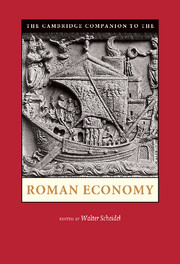Book contents
- Frontmatter
- Contents
- List of Figures
- Note on the Contributors
- Abbreviations
- The Roman world at the time of Marcus Aurelius
- 1 Approaching the Roman economy
- Part I Theory
- Part II Labor
- Part III Production
- Part IV Distribution
- 10 Predation
- 11 Transport
- 12 Urbanism
- 13 Money and finance
- 14a A forum on trade
- Part V Outcomes
- Further reading*
- Bibliography
- Index
14a - A forum on trade
from Part IV - Distribution
Published online by Cambridge University Press: 05 February 2013
- Frontmatter
- Contents
- List of Figures
- Note on the Contributors
- Abbreviations
- The Roman world at the time of Marcus Aurelius
- 1 Approaching the Roman economy
- Part I Theory
- Part II Labor
- Part III Production
- Part IV Distribution
- 10 Predation
- 11 Transport
- 12 Urbanism
- 13 Money and finance
- 14a A forum on trade
- Part V Outcomes
- Further reading*
- Bibliography
- Index
Summary
Interstate treaties in Classical Greece normally specified reciprocal trading rights; Latin citizenship was defined partly in terms of trading privileges, and the Punic Wars were fought over the control of trading zones in the central Mediterranean. The persistent reluctance of many historians in the later twentieth century to admit the extent and importance of long-distance trade in the ancient world is therefore difficult to understand, and indeed utterly incomprehensible when one considers the archaeological evidence in addition to the written record.
Long-distance trade, already important in the Hellenistic period, increased further with the gradual unification of the Mediterranean under Rome, and the virtual eradication of piracy by Pompey. By the Augustan period all the regions surrounding the Mediterranean were controlled either directly by Rome or indirectly through its client kings, and with this unified political control came a single currency throughout most of the region, common institutional frameworks in the form of laws, market supervision and regulation, and state investment in road networks, canals, and harbors. All of these greatly reduced transaction and transportation costs and facilitated the growth of trade. Many of the goods available in the markets of any city, and especially in coastal ports, were produced in the territory of another city, and often in another province; this applies to staples as well as luxuries.
- Type
- Chapter
- Information
- The Cambridge Companion to the Roman Economy , pp. 287 - 318Publisher: Cambridge University PressPrint publication year: 2012
- 8
- Cited by

